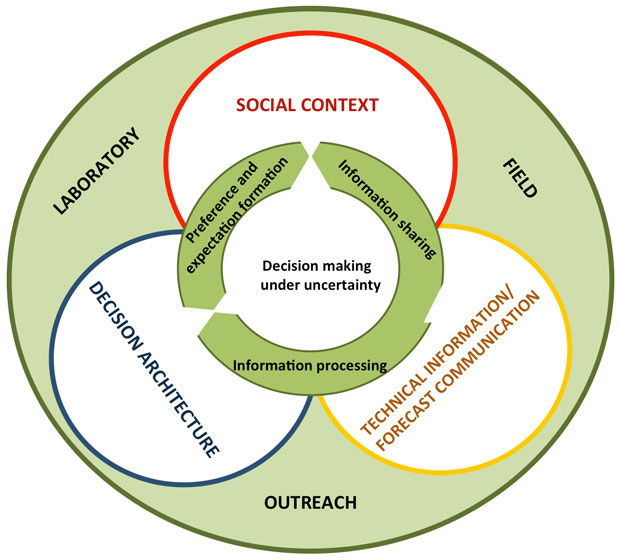Research
Three themes connect our research projects: How scientific information is or should be presented and
used, the role of social context, and decision architecture.
Use of Scientific Information
To an increasing extent, environmental decisions involve scientific or technical information or the search for such information. Often it takes the form of a forecast, structured either as the probability of a critical event or as a probability distribution over different events. The use of forecasts by decision makers is often hindered by misperceptions, mistrust, and other such barriers. CRED research examines how scientific information, including seasonal-to-interannual forecasts, decadal predictions, long-term climate change projections, natural hazard forecasts, and technical information related to energy consumption, can be communicated and used more effectively.
Our research explores, integrates, and tests applicability of two major recent themes in decision making to improve the use of scientific information: Social Context and Decision Architecture.
Social Context
Often omitted from models of decision-making under uncertainty, Social Context includes both explicit social interchange and setting which activate social goals and expectations about others’ goals and strategies. Social context motivates concern for others and enhances conformity to and setting of social norms, which might receive little weight from isolated decision makers. Group meetings, discussion, and participatory processes also alter the ways in which people acquire, learn, engage with, and act on new information. We study individual decisions in group settings, commons dilemmas, as well as group decisions.
Decision Architecture
Decision Architecture refers to a body of insights about how people’s preferences are constructed as a function of contextual characteristics of the decision setting (e.g., whether issues are framed as gains or losses, what implicit temporal horizon is suggested, what the choice default is, or in which order information is received). Contextual features help determine the goals that decision makers consider, how information is combined, how the merits of adaptive and mitigative strategies are taken into account. CRED studies the cognitive, emotional, and motivational, processes involved.
Social context is a component of decision architecture, but also interacts with other structural features of decision architecture. Understanding these processes and interactions is key to the design of solutions to environmental problems and sustainable development, from more effective information formats and education programs to better predictions of public acceptance of new technologies and other
interventions.
CRED’s Multi-Method Approach
CRED’s program of research includes laboratory and field studies. Most projects contain both, in varying proportions. Field experiments are based on lab results. In turn, we use insights from field observations to modify our laboratory protocols or to suggest new lab experiments that can study select decision mechanisms in isolation. This integrated back and forth between lab and field leads to better understanding of individual and group processes and more efficient field observation. We also conduct many of our surveys and decision experiments online, with access to more broadly representative samples of respondents.




